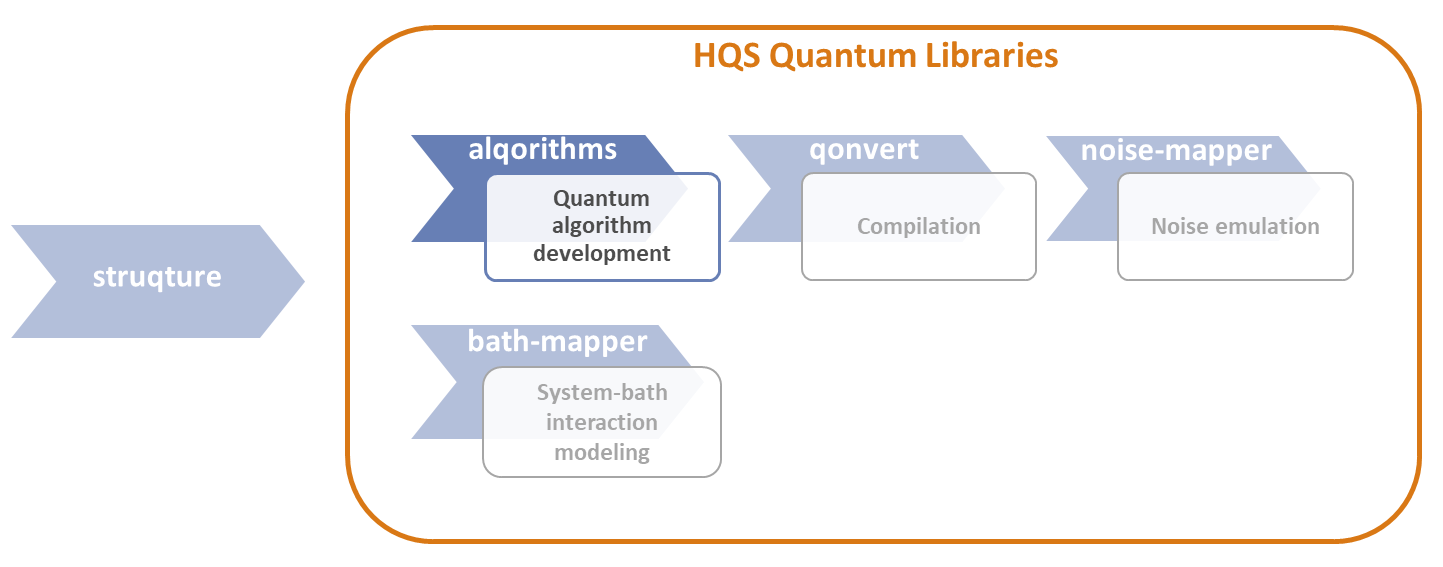Introduction
The alqorithms package is part of the HQS Quantum Libraries by HQS Quantum Simulations, which contain the modules alqorithms, qonvert, noise-mapper and the bath-mapper, as shown in Figure 1. The HQS Quantum Libraries encompass a comprehensive suite of modules tailored to advanced quantum computing tasks, where alqorithms is the package providing quantum algorithm development features.

Figure 1: HQS Quantum Libraries - Alqorithms
Applications
Quantum algorithms form the foundation of any software application intended for use on a quantum computer. In the gate-based quantum computing paradigm, these algorithms are implemented as quantum circuits composed of gate operations. Measurements are performed at the end of such circuits to extract computational results. The alqorithms package is a comprehensive toolkit that facilitates these major stages of quantum algorithm development. Its key features include:
- Tools for constructing quantum circuits.
- A collection of algorithms for generating the Trotterized time evolution of quantum systems. These include the ParityBased (CNOT) algorithm, the QSWAP algorithm, and the Mølmer-Sørensen algorithm.
- Circuit-building utilities for diverse measurement schemes.
- Algorithms for computing two-point correlation functions.
Whether the user has a pure system Hamiltonian or a system-bath Hamiltonian, the generated circuits can be executed on a quantum computer using our open-source qoqo-backends.
Getting started
The package can be installed with the following command:
hqstage install py_alqorithms
Please note that the HQS Quantum Libraries are currently only supported on Linux and MacOS.
For an expanded collection of examples please see the examples section.
Features
The currently supported quantum algorithms in the HQS alqorithms package are
- the CNOT algorithm, which assumes qubits with all-to-all connectivity,
- the Mølmer-Sørensen Algorithm, which is similar to the CNOT algorithm but implements a different two-qubit gate,
- and the QSWAP algorithm, which assumes qubits with linear connectivity.
All of these algorithms can take a pure system Hamiltonian or a system-bath Hamiltonian, and the generated circuit can be run on a quantum computer using the HQS open source qoqo-backends.
Furthermore, alqorithms includes tools to create quantum circuits that prepare measurements, which are essential to read out information in quantum computing algorithms. Additionally, the HQS package provides functionalities to perform quantum simulations of two-point correlators in the infinite temperature state. The user can also apply a symmetrization on a spin system to simplify the computation.
The core alqorithms package is written in Rust, and features a Python interface named py-alqorithms. Thus, it combines the performance and memory safety benefits of Rust with the user-friendly accessibility of Python. Rust ensures high-efficiency and reliable execution. The Python interface makes the package usable for a broader audience from the Python's extensive ecosystem, while leveraging the Rust-based core. This setup offers the best of both worlds—high performance at the core and easy integration and prototyping through Python.
The API documentation can be found at the following link: